Dev Lok – Dev Log
Manohar ‘Mohabbat’ Iyer | keepalivemusic@gmail.com
सौ साल पहले मुझे तुमसे प्यार था; आज भी है और कल भी रहेगा…
Defragmenting the Films and Fraternity of the Ageless Anand on his Birth Centenary.
26 September 2023 marks the Birth Centenary of the dashing and debonair ageless actor DEV ANAND.
I am a big DEVotee of Dev Anand as I am of his two contemporaries Dilip Kumar and Raj Kapoor. Many moons ago, I made a mention in a stage programme that, as compared to the other two, Dev Anand was ‘more style, less substance’. My innocuous and perceptive statement irked some of his staunch admirers while some others agreed.
Be that as it may. My or as a matter of fact, anyone else’s perception about him cannot rob or belittle in any way the tremendous name, fame, glory, popularity and success that he earned and enjoyed during his active years and retained till his last and even thereafter. Dev Anand and his magic is eternal and everlasting. As the Amul ad puts it aptly and succinctly, ‘Devergreen Anand’!
My fondness for Dev Anand was because of something striking and salient in him with which I, at the risk of sounding immodest, could relate myself; his childlike restlessness, youthful charm, ceaseless energy and effervescence, zeal and zest for people, work, cinema, music, life; love and respect for every moment which is a golden gateway to newer opportunities and possibilities. Doesn’t that make me his bigger fan?
Circa 1993
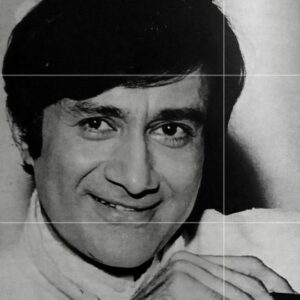 I was writing a song for the film ‘Aaja Meri Jaan‘ which had music by Amar – Utpal (of ‘Shehanshah’ fame). Amar had some work in Anand Recording Studio owned by Dev Anand in Pali Hill, Bandra and he took me along.
I was writing a song for the film ‘Aaja Meri Jaan‘ which had music by Amar – Utpal (of ‘Shehanshah’ fame). Amar had some work in Anand Recording Studio owned by Dev Anand in Pali Hill, Bandra and he took me along.
A moment of pure serendipity happened. We bumped into the demigod named Dev Anand and Amar greeted him and introduced me to him. I had the privilege of shaking hands with Dev sahab. I greeted him with a nervous excitement and, suddenly, with a childlike eagerness, I blurted out that I was a big fan of his. He chuckled and shot back with a mischievous smile ‘Everyone says so’; meaning there was nothing new to it.
Amar was quick to endorse my claim and add: ‘Dev sahab, he is unique, an encyclopaedia and knows a lot about vintage films and film music’. Dev sahab looked at me with a questioning curiosity. Before he could leave, I rattled off in one breath about his debut film, the films of his formative years, the films he made under his banner, his association with S D Burman, etc.
I don’t remember where I put a stop. I knew I had impressed him no end. Dev sahab acknowledged my ‘craze’ and ‘knowledge’ with his famous toothless grin and a pat which are as ageless and timeless as the actor who turns a historic hundred today.
Centenary Celebration
I wanted to mark the Centenary Celebration of Dev Anand in my own humble way. After toying with several options, I crystallised on the more enjoyable, entertaining and easy exercise i.e., sharing trivia and titbits on the over 100 films that he did in an illustrious career spanning five decades. I will unveil a film or two every two days which should keep me as well as all his admirers engaged in the centenary celebrations for at least six months or more.
In the inaugural instalment, I share details on his debut film ‘Hum Ek Hain’ with which one is unable to relate the dashing and debonair actor Dev Anand!
Hum Ek Hain (1946)
‘Hum Ek Hain‘ has the distinction of being the debut film of Dev Anand which was released in 1946 when Dev Anand was just 23.
The film was produced by the restructured Prabhat Film Company and directed by P L Santoshi, also his directorial debut. The film also marked the debut of Kamla Kotnis as the lead heroine, Rehana (Santoshi was to get besotted by her soon) and Rehman in supporting roles. Guru Dutt is credited for ‘Dance Composition’. The friendship between Dev Anand and Guru Dutt as also between Guru Dutt and Rehman began and blossomed while working in Prabhat.
‘Hum Ek Hain’, as the title suggests, had a patriotic fervour and the film sent the message across of national integration and unity. The story revolved around a benevole
nt and largehearted land lady (Durga Khote) who brings up her own son (who grows up to Dev Anand) along with three destitute children (who grow up to Rehman, Rane R V and Ranjitkumari) orphaned and rendered homeless during a famine in the village. They belong to different caste and creed and follow their respective faiths. They are inculcated values of respecting each other’s religion and taught to remain united especially in times of a crisis.
A rival zamindar (Ramsingh) sets out to seek revenge and brings discord in the family and separates them. Reason: the girl (Kamla Kotnis) he has his eyes on, falls for the land lady’s son and gets married to him. After a lot of misunderstanding and melodrama, the disintegrated brothers unite reiterating ‘Hum Ek Hain’!
The zamindar lady’s landed property, her children and the rival zamindar were analogous to the country, countrymen and the Britishers respectively.
Interestingly, the film’s credits ascribed the ‘original story treatment’ to Saleh Mohammed Qureshi, Tony Lazarus and P L Santosh belonging to three different religions.
Story, dialogues and lyrics were written by P L Santoshi and music was by Husanlal-Bhagatram. The songs were a deviation from their typical Punjab folk style and had the vintage feel of the 30s.
The film had two patriotic songs with the film’s title in the lyrics: ‘Qila hai buland dekho‘ and ‘Kabhi ruke na ye naiyya hamari‘ and a song in the climax ‘Hum jaag uthe hain so kar‘. There was a fast-paced kite song ‘Charkhiwale o, zara dheel de‘, probably the first flighty song heard in films.
Coming a year before independence, the film with its strong nationalistic content and intent and the catchphrase ‘Hum Ek Hain’ repeatedly hammered by the characters appealed and inspired the masses.
Baburao Patel, the revered and feared writer – publisher wrote positively about the film in his magazine ‘Film India’: “It has a theme with a purpose that ought to find a response in the hearts of millions in our country.” A word of praise coming from him for Dev Anand’s performance made the audience take note of him too, along with Dilip Kumar who had already made his debut with ‘Jwar Bhata’ in 1944.
 Dev Anand recalls an interesting incidence about the film in his autobiography ‘Romancing with Life’:
Dev Anand recalls an interesting incidence about the film in his autobiography ‘Romancing with Life’:
“One day, as we (he and Guru Dutt) were traveling together by train in Bombay, Guru Dutt suddenly gasped looking at a poster on the railway platform: ‘That’s you’!”
“By the time I Iooked back, the local train had moved on and I could only see the poster as it passed out of sight. I could not register anything of its contents.”
“It’ll probably be boring for you but I’d Iike to get back and see myself hanging at a railway platform, Iike I had seen Ashok Kumar’s banner once” I told Guru Dutt.
“He agreed to indulge me. We came back in the same train without getting off and postponed the proposed destination we were off to, to a later time”.
“Standing at the railway station, watching my face on a movie poster for the first time, with a few people staring at it with pleasant curiosity, was a thrilling experience.”
‘Hum Ek Hain’ was released and Dev Anand was accepted by the audience.
To quote him again “Acceptance by the people erases all of one’s flaws, drawbacks and shortcomings.” Even the gaps between his teeth suddenly started looking ‘cute’ and ‘kissable’!
Thanks to Santoshi who had asked the wannabe actor to throw the artificial fillers which he had carried or worn when he first went to meet Santoshi. Thank God, he didn’t have to face literally any ‘teething problems’ necessitating the use of the fillers. The legendary toothless grin is what makes Dev Anand more special!
Dev Anand had ‘arrived’ as a newcomer. And he kept moving ahead. Incidentally, the title of his next film was: ‘Aage Badho’!
To be continued…



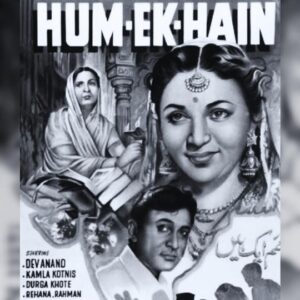

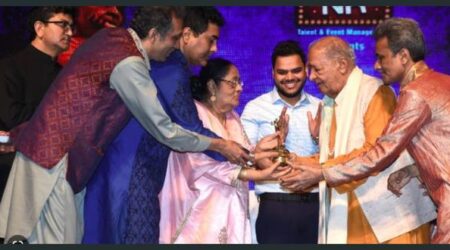

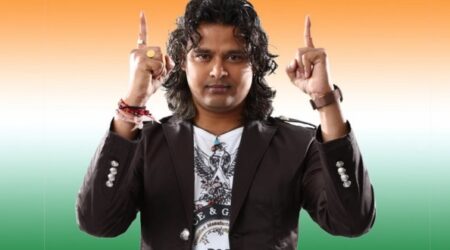




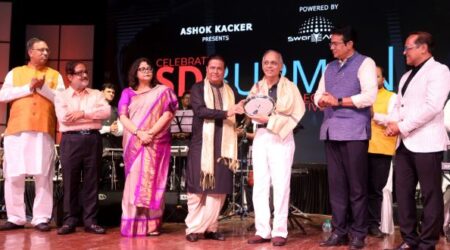
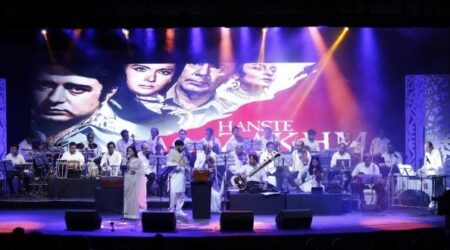

Leave a Reply